Stories > Clear Communication
Clear Communication
Innovative face shields developed by Singapore’s ITE College East help to improve voice projection through masks of teachers and frontline personnel, while reducing Covid-19 transmission risk.
BY AUDRINA GAN
here are few sectors left unscathed by the upheaval caused by the ongoing Covid-19 pandemic, which has dramatically changed the way individuals and organisations live and function.
Take the education industry, for instance. Singaporean educator Roy Tan, the section head of the Institute of Technical Education (ITE)’s chemical process technology department, says that he now needs to extensively use online teaching methods.
To observe safe-distancing measures, he must don a mask and face shield when teaching in classrooms. He also wears a microphone so students can hear him through the mask. And to optimise the microphone for his teaching, he needs to keep a battery pack by his side to charge the microphone.
A wired microphone, especially during practical sessions when instructors must handle plenty of equipment, was deemed too cumbersome. There was also the issue of whether he could be heard by his students, with the protective layers of masks and face shields inevitably muffling his voice.
INNOVATION AT WORK
Seeing these challenges, Tan came up with the idea of integrating the melaphone – a device used for communicating in germ-free environments like laboratories – with a standard face shield that would allow them to be heard clearly from a distance.
“During the circuit breaker period in 2020, we decided to adapt the melaphone design onto an existing face shield to improve its sound quality. The enhanced face shield could also provide the necessary protection against Covid-19,” he says.
After its ideation, he gathered a small team from the college’s School of Engineering and Technology Development Centre to test and develop different prototypes. From conceptualising a new design, making a prototype and putting it to the test, the team produced three to four iterations before settling on a final product.
“We tested various materials and their thickness for the diaphragm cover, the sizes of the melaphone slots, and also adhesives to optimise the quality of the projected sound,” he explains. To expedite delivery of the product, he and his colleagues also shortened the prototyping phase by modifying an off-the-shelf face shield.
The project was not without its challenges. Disruptions to the global supply chain, for instance, made securing materials a major challenge. “By working with our industry partners, our team was able to resolve the material shortage issue,” he says. “We also made use of our College Makerspace – an on-campus innovation-driven facility that provides a conducive space for students and staff to explore new solutions to everyday challenges using technology – and manpower resources to laser-cut and prototype our face shield designs.”
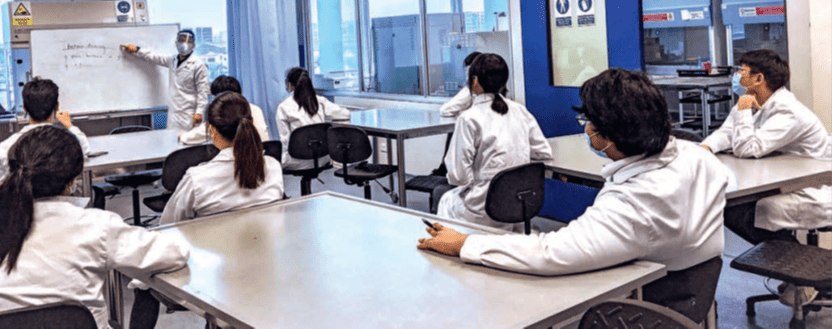
The Speak & Shield being used during a lecture at ITE College East.
Tan says the Speak & Shield significantly improves the user’s voice projection, enabling the user to be heard more clearly by others – even while wearing a face mask. “This is due to the embedding of a Mylar diaphragm, a hydrophobic material that repels moisture on the face shields,” he explains. Indeed, the team had chosen to use food-grade Mylar – a transparent, tough film with excellent moisture and chemical resistance properties that make it the ideal material for surgical or medical face shields. Notably, the design allows the Mylar diaphragm to vibrate more effectively by enhancing sound transmission.
Tests were conducted in a typical classroom environment using a sound pressure level (SPL) meter taken five metres away from a consistent audio source. Results showed an increase in SPL of up to four decibels for speakers using the enhanced face shield. “By combining the melaphone and the diaphragm to create a vibration that amplifies the sound quality of the user, students in the classroom who are five metres apart can hear their teachers better,” elaborates Tan.
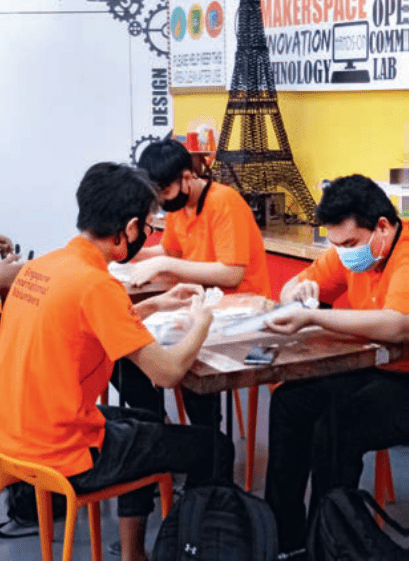
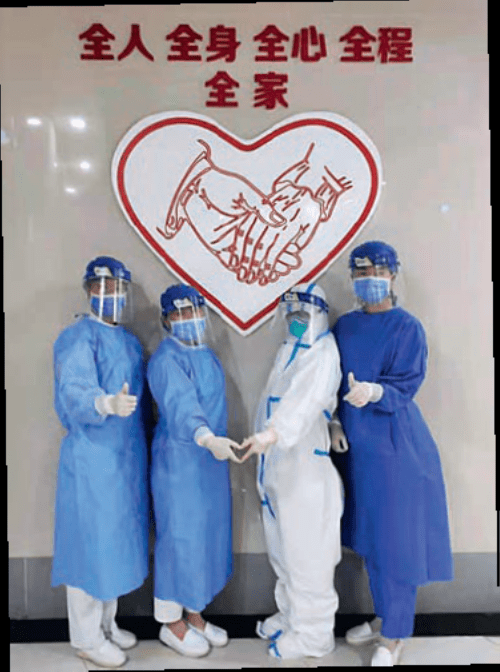
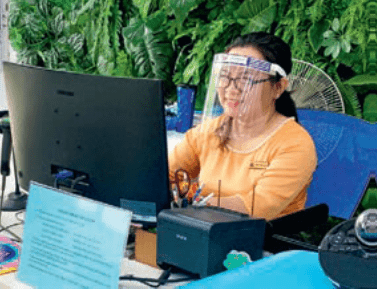
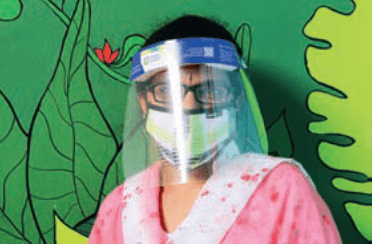
The Speak & Shield project saw 18 ITE College students volunteer to help in the production, testing and packaging of the face shields; partners of the SIF that have benefitted from the initiative include the General Sciences Library in Ho Chi Minh City; the New Kunhua Hospital in Yunnan, China; and the Parikrma Centre for Learning in India.
“The face shield I received from the SIF is transparent, and I feel comfortable using it to teach my students Class 10 mathematics.”
Latha Selvan, principal at Parikrma Centre For Learning, Bangalore, India
CONTRIBUTING TO SOCIETY
Dr Yek Tiew Ming, ITE College East principal, says the development of the Speak & Shield reflects the core values of the institution: enterprise and innovation. “The project is an inspiration that came about from our focus to meet the needs of educators and students during the Covid-19 pandemic,” he observes. “What’s interesting about the Speak & Shield is the way the melaphone design has helped to improve voice projection, while guarding against aerosol transmission at the same time.”
To extend the benefits of the Speak & Shield beyond Singapore, ITE College East teamed up with the Singapore International Foundation (SIF) to reproduce more than 1,000 face shields – and deliver them to over 70 of the SIF’s local and overseas partners in 11 countries. The team roped in 18 students, who answered an open call to the volunteering opportunity, and were subsequently involved in the production.
The community project is an extension of the school’s long-time partnership with the SIF. “Our students had been volunteering in the SIF’s Water for Life Programme in Cambodia since 2013, and have benefited greatly,” says Dr Yek. “Due to Covid-19, these students are not able to travel or work with our friends overseas. But we are heartened that we can still share this innovation with our overseas friends and communities through this project.”
SOLVING REAL-LIFE CHALLENGES
With a firm belief in giving back to society, ITE College East student Kuong Kai Ying volunteered for the project. And she echoes Tan’s sentiments that such programmes benefit the students tremendously by allowing them to derive solutions to real-life challenges. “I hope that my efforts, however small, will help in the fight against Covid-19,” she says.

SIF’s executive director, Jean Tan, and ITE College East principal Dr Yek Tiew Ming at the latest signing of a Letter of Collaboration between the two organisations in 2019.
The Speak & Shield has had an impact well beyond the borders of Singapore. For the General Sciences Library (Vietnam) – a long-standing partner of the SIF’s Words on Wheels community service programme – which runs a public library in Ho Chi Minh City, the face shields have provided their staff with an additional layer of protection against Covid-19.
At the Parikrma Humanity Foundation, which runs four learning centres for children from local slum communities in India’s Bangalore city, the teachers said the face shields have helped to address their concerns about teaching in a physical classroom during the pandemic. “The face shield I received from the SIF is transparent, and I feel comfortable using it to teach my students Class 10 mathematics,” says Latha Selvan, principal at Parikrma Centre For Learning in the Jayanagar neighbourhood.
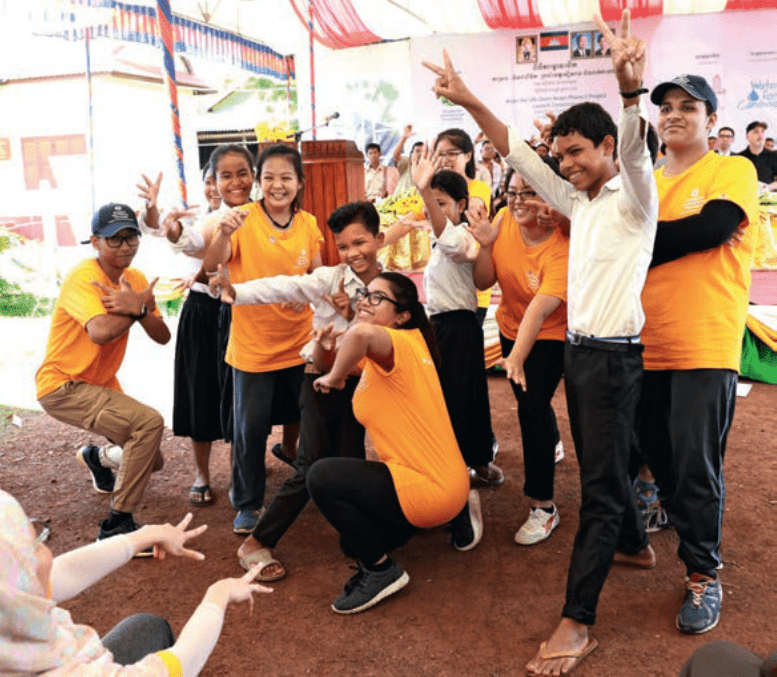
The SIF-ITE collaboration has seen the latter’s students volunteer in Cambodia for the SIF’s long-running Water for Life Programme.
“OUR STUDENTS HAD BEEN VOLUNTEERING IN THE SIF’S WATER FOR LIFE PROGRAMME IN CAMBODIA SINCE 2013, AND HAVE BENEFITED GREATLY. WE ARE HEARTENED THAT WE CAN SHARE THIS INNOVATION WITH OUR OVERSEAS FRIENDS THROUGH THIS PROJECT,” SAYS DR YEK TIEW MING.
Since it was first launched in June 2020, the Speak & Shield has been updated. It features extra folded sides for added protection. It also comes with an option to apply antibacterial coatings. The design team also removed a sponge previously used to trap perspiration, thus making the face shield smaller and more portable.
Over the past year, ITE College East has received enquiries and interest from more than 25 schools, eight government agencies and several non-governmental organisations. “Our customers’ feedback has led us to review and improve the face shield,” Tan shares. “The new version made with recyclable materials allows us to reduce packaging and material wastage in the manufacturing process.”
